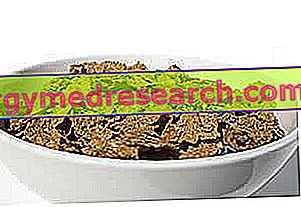"Dietary fiber is a typical, but not exclusive, component of plant-based foods; it differs in soluble and insoluble, or better, in viscose and not viscous".
Dietary fiber deficiency is one of the major causes of contemporary malnutrition in developed countries.

The lack of dietary fiber cannot be univocally determined; the first symptoms of dietary fiber deficiency are affecting the intestine and compromising fecal expulsion. In summary, the lack of dietary fiber frequently causes:
- Constipation
- Pain, cramps, tension, abdominal swelling (and related impairment of lifestyle and mood)
To these short-term clinical symptoms / signs - potentially linked to both deficiency and excess dietary fiber - are added others in the long term:
- Tendency to diverticulosis
- Potential aggravation of idiopathic-psychogenic colitis (viscous fibers essential)
- Potential aggravation of irritable bowel syndrome
- Alteration of intestinal bacterial flora
- Accumulation of waste in the digestive tract
- Irritation of the intestinal mucosa
- Tendency to anal / rectal fissures
- Tendency to hemorrhoids
- Tendency to intestinal neoplasms (colorectal cancers)
- If the fiber deficiency is associated with inappropriate food behaviors (eg alcohol abuse, excess saturated fat and simple sugars, high-calorie food):
- Tendency to overweight
- Tendency to hypercholesterolemia (viscous fibers essential)
- Tendency to hyperglycemia (viscous fibers essential)
- Tendency to hypertriglyceridemia (viscous fibers essential)
- Tendency to hypertension
- Increased overall cardiovascular risk
- Tendency to abuse of laxatives and consequent addiction.
From the above, it seems obvious that the lack of dietary fiber (not yet considered a full-fledged nutrient, but rather a nutritional molecule with both functional and metabolic beneficial functions) is extremely harmful to the body (especially in the long term).
Viscous and non-viscous fibers: are they the same?
As anticipated, the dietary fiber can be classified as viscose and not viscous; many readers will find this split quite different from the traditional one, which differentiates fiber into soluble and insoluble. However, the most recent investigations have shown that the solubility or non-solubility of the fiber are not always correlated to the effects of gelation, for which we can obtain: reduction of cholesterol absorption, modulation of fat and sugar absorption, effect satiating for gastric filling, prebiotic effect, etc .; therefore, it would seem more logical to distinguish the fibers on the basis of the reaction they manifest inside the digestive tract. On the other hand, we recall that on the food labels of products that can be purchased on the market, there is (for the moment) no obligation to distinguish viscous fiber from non-viscous fiber and under the heading "fibers" are grouped: cellulose, hemicellulose, pectin gum, polysaccharides NOT available and lignin. NB . If "polysaccharides not starch" appeared in place of "fiber", lignin would be excluded from the aforementioned list.
The lack of dietary fiber is therefore attributable to the insufficiency of this component in the diet, which, to be defined as balanced, in the annual average should NOT contain less than 21g / day; it is however necessary to specify that a contribution equal to 30g / day, more often than not, constitutes a uniform weight suitable for the preservation of the intestinal functionality both in the adult man and woman (the female tends to be more constipated than the man). NB . Even the excess of dietary fiber can be an unwanted aspect, therefore, the rule of "the more you eat it, the better!"
Similar but not analogous are non-digestible oligosaccharides and polyalcohols; it seems that these non-digestible molecules (along with NON-digested fructose and lactose) play a prebiotic role similar to that of dietary fiber, reaching the colon intact and acting as a growth substrate for the beneficial bacteria of the intestine. NB . Even their excess (like fiber) can produce functional side effects (gas, diarrhea, cramps, etc.).
Combat dietary fiber deficiency
Let's start by specifying that: the recommended ration of dietary fiber useful to avoid its deficiency SHOULD be achieved through the consumption of food (possibly mostly raw) and not of bran tablets or food supplements; this statement is justifiable by the fact that (to date) it is not yet possible to establish with certainty and weighting what the most useful molecules contained in plant foods are, and what biological role they may have on nutrition and human health. It is therefore possible that there are other components that are equally (or more) decisive (see non-digestible polyalcohols and oligosaccharides) NOT yet isolated or absent in food supplements, which cannot be dispensed with; therefore, to avoid the possibility of a lack of dietary fiber, it is necessary to consume (with a frequency well estimated by national guidelines) foods of vegetable origin such as: legumes, national vegetables, national fruit and cereals (possibly "whole" and whole) ).
Foods rich in fiber
Foods rich in viscous fibers: oats and derivatives, carrots, onion, apple peel and albedo of citrus fruits, legumes (dried beans, peas and lentils) and flax seeds, are excellent sources of viscous fibers.
Foods rich in non-viscous fibers: whole grains, green leafy vegetables, nuts, flax seeds, are excellent sources of non-viscous fibers.
NOTE: both types of fiber, viscose and non-viscose, are present in all plant foods, although in different proportions.
Foods with a higher total fiber content
(per 100 g of edible portion)
| Food | Total fiber content (g / 100 g) |
| wheat bran | 42, 40 |
| Broad beans, dried | 21, 10 |
| Cannellini beans, dry, raw | 17, 60 |
| Beans, dried, raw | 17, 50 |
| Borlotti beans, dry, raw | 17, 30 |
| Peas, buckets | 15, 70 |
| Pop corn | 15, 10 |
| Flour, rye | 14, 30 |
| passionflower | 13, 90 |
| Lentils, dried, raw | 13, 80 |
| Chickpeas, dried, raw | 13, 60 |
| Dried beans from the eye | 12, 70 |
| Almonds, grooves, dried | 12, 70 |
| Soy, dry | 11, 90 |
| Flour, soy | 11, 20 |
| Peanuts, toasted | 10, 90 |
| Pistachios | 10.60 |
| Wheat, hard | 9.80 |
| Common wheat | 9.70 |
| Pecan nuts | 9.40 |
| Pearl barley | 9.20 |
| Dates, buckets | 8.70 |
| Flour, whole wheat | 8.40 |
| Black truffle | 8.40 |
| Prunes, dried | 8.40 |
| Oatmeal | 8.30 |
| Lentils, dried, boiled | 8.30 |
| Hazelnuts, dried | 8.10 |
| Dark chocolate | 8.00 |
| Artichokes, boiled | 7.90 |
| Beans, dried, boiled | 7.80 |
| Cannellini beans, dried, boiled | 7.80 |
| Flour, oats | 7.60 |
| Raspberries | 7.40 |
| Broad beans, dried, shelled | 7.00 |
| Borlotti beans, dried, boiled | 6.90 |
| Brewer's yeast, compressed | 6.90 |
| farro | 6.80 |
| Bread, integral type | 6.50 |
| Muesli | 6.40 |
| Peas, fresh, stir-fried | 6.40 |
| Peas, fresh, raw | 6.30 |
| Nuts, dried | 6.20 |
| Biscuits, whole wheat | 6.00 |
| Buckwheat | 6.00 |
| Broad beans, stir-fried | 5.90 |
| Quince | 5.90 |
| Chickpeas, dried, boiled | 5.80 |
| Chickpeas, canned, drained | 5.70 |
| Borlotti beans, canned, drained | 5.50 |
- Recommended Nutrient Intake Levels for the Italian Population (LARN) - Italian Society of Human Nutrition (SINU).



